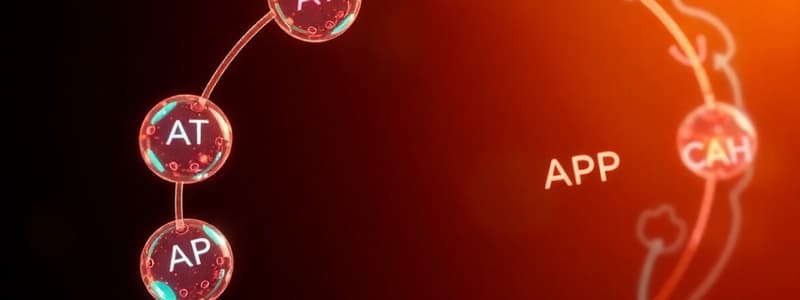Podcast
Questions and Answers
What type of reaction releases energy by breaking down larger molecules into smaller subunits?
What type of reaction releases energy by breaking down larger molecules into smaller subunits?
- Metabolic reactions
- Anabolic reactions
- Catabolic reactions (correct)
- Coupled reactions
Anabolic reactions synthesize larger molecules and do not require energy.
Anabolic reactions synthesize larger molecules and do not require energy.
False (B)
What are the smaller building blocks produced from the catabolic breakdown of food called?
What are the smaller building blocks produced from the catabolic breakdown of food called?
cellular building blocks
Catabolic pathways break down food into smaller __________, releasing energy in the process.
Catabolic pathways break down food into smaller __________, releasing energy in the process.
Match the following terms with their descriptions:
Match the following terms with their descriptions:
What does BMR stand for?
What does BMR stand for?
RMR accounts for the calories burned during the digestion of food.
RMR accounts for the calories burned during the digestion of food.
What is the primary difference between BMR and RMR?
What is the primary difference between BMR and RMR?
The formula to calculate BMR for men includes _______ for weight.
The formula to calculate BMR for men includes _______ for weight.
Match the following components with their descriptions:
Match the following components with their descriptions:
What is the primary function of ATP in cells?
What is the primary function of ATP in cells?
ADP is considered a 'charged battery'.
ADP is considered a 'charged battery'.
What is released when the bonds in food are broken?
What is released when the bonds in food are broken?
ATP is converted to ADP when energy is ______.
ATP is converted to ADP when energy is ______.
Match the component of ATP/ADP to its description:
Match the component of ATP/ADP to its description:
Which factors are included in the BMR formula?
Which factors are included in the BMR formula?
Genetics and hormones are major factors included in standard BMR formulas.
Genetics and hormones are major factors included in standard BMR formulas.
What does a higher BMR indicate?
What does a higher BMR indicate?
The BMR formula for men includes the term 66.47 + (6.24 * weight in ______) + (12.7 * height in inches) - (6.755 * age).
The BMR formula for men includes the term 66.47 + (6.24 * weight in ______) + (12.7 * height in inches) - (6.755 * age).
Match the BMR formulas with the correct gender:
Match the BMR formulas with the correct gender:
What is the primary function of the stomach in the digestive system?
What is the primary function of the stomach in the digestive system?
The pancreas is responsible for producing saliva.
The pancreas is responsible for producing saliva.
What role does the gallbladder play in digestion?
What role does the gallbladder play in digestion?
The process of breaking down food into smaller molecules is called __________.
The process of breaking down food into smaller molecules is called __________.
Match the digestive organs to their primary functions:
Match the digestive organs to their primary functions:
Which enzyme is responsible for breaking down carbohydrates into simpler sugars?
Which enzyme is responsible for breaking down carbohydrates into simpler sugars?
Pepsin is an enzyme that acts on lipids during digestion.
Pepsin is an enzyme that acts on lipids during digestion.
What is the function of amylase in the digestive system?
What is the function of amylase in the digestive system?
_________ is the enzyme that helps digest milk sugar.
_________ is the enzyme that helps digest milk sugar.
Match the following enzymes with their respective substrates:
Match the following enzymes with their respective substrates:
Which of the following is NOT a part of the gastrointestinal tract?
Which of the following is NOT a part of the gastrointestinal tract?
Fats are primarily broken down in the stomach.
Fats are primarily broken down in the stomach.
Name the last two parts of the gastrointestinal tract in order.
Name the last two parts of the gastrointestinal tract in order.
The _____ is responsible for the absorption of nutrients in the digestive system.
The _____ is responsible for the absorption of nutrients in the digestive system.
Match the following parts of the gastrointestinal tract with their functions:
Match the following parts of the gastrointestinal tract with their functions:
What is the primary function of the liver in the gastrointestinal tract?
What is the primary function of the liver in the gastrointestinal tract?
The gallbladder is responsible for producing digestive enzymes.
The gallbladder is responsible for producing digestive enzymes.
Name one enzyme secreted by the salivary glands.
Name one enzyme secreted by the salivary glands.
The pancreas secretes digestive enzymes, including ________ for protein digestion.
The pancreas secretes digestive enzymes, including ________ for protein digestion.
Match the accessory organs with their primary functions:
Match the accessory organs with their primary functions:
What is the purpose of biting and chewing in the mouth during digestion?
What is the purpose of biting and chewing in the mouth during digestion?
Peristalsis refers to the process of mixing food in the stomach.
Peristalsis refers to the process of mixing food in the stomach.
What are the three stages of stomach activity involved in mechanical digestion?
What are the three stages of stomach activity involved in mechanical digestion?
During mechanical digestion, the stomach undergoes __________ to mix food with gastric juices.
During mechanical digestion, the stomach undergoes __________ to mix food with gastric juices.
Which of the following is NOT a function of the digestive system?
Which of the following is NOT a function of the digestive system?
Match the following terms with their descriptions:
Match the following terms with their descriptions:
Digestion includes both mechanical and chemical processes.
Digestion includes both mechanical and chemical processes.
What process involves taking up the basic building blocks from the GI tract into the blood?
What process involves taking up the basic building blocks from the GI tract into the blood?
The process of eliminating non-absorbed waste from the body is called __________.
The process of eliminating non-absorbed waste from the body is called __________.
Match the functions of the digestive system with their descriptions:
Match the functions of the digestive system with their descriptions:
Flashcards are hidden until you start studying
Study Notes
Energy
- Cells require energy for growth, repair, and movement.
- Energy is released by breaking down food molecules.
- This energy is used to make ATP (adenosine triphosphate).
- ATP is like a battery for cells, storing energy and releasing it when needed.
- ATP is converted into ADP (adenosine diphosphate) when energy is released.
- ADP is converted back into ATP when energy is used to add a phosphate group.
Metabolism
- Metabolism describes the biochemical reactions that maintain life within a living organism.
- Catabolic reactions break down larger molecules into smaller ones and release energy.
- Anabolic reactions build larger molecules from smaller ones and require energy.
- Catabolic and anabolic reactions are coupled, meaning they are dependent on each other.
Metabolic Rates
- A metabolic rate is the amount of energy (calories) spent in a certain amount of time.
- Metabolic rates can vary greatly between individuals.
- The Basal Metabolic Rate (BMR) is the number of calories burned during basic life-sustaining functions, while resting.
- The Resting Metabolic Rate (RMR) includes the energy required for digestion, and is measured when resting.
- The Harris-Benedict formula is used to calculate BMR, taking into account:
- Weight
- Height
- Age
- Sex
- The higher the BMR, the more calories an individual needs/burns per day.
- Genetics and hormones also influence BMR.
Digestion
- Food needs to be broken down into small components for absorption into the bloodstream or lymph.
- This breakdown occurs in the digestive system, also known as the gastrointestinal tract.
- The gastrointestinal tract is a long muscular tube that provides space for digestion and absorption of nutrients.
Major Structures and Organs of the Digestive System
- Mouth: Chews food and mixes it with saliva, starting mechanical digestion.
- Salivary glands: Produce saliva containing salivary amylase, an enzyme that breaks down starch.
- Pharynx: Swallows the chewed food (bolus).
- Esophagus: Transports the bolus to the stomach.
- Stomach: Mixes and churns food with gastric juice containing acid and pepsin, a protein-digesting enzyme; creating chyme.
- Liver: Produces bile, which aids in fat digestion and absorption.
- Pancreas: Releases bicarbonate to neutralize intestinal contents, and produces enzymes for carbohydrate, protein, and fat digestion.
- Gallbladder: Stores bile and releases it into the small intestine.
- Small Intestine: Digests food and absorbs nutrients.
- Large Intestine: Absorbs water and some vitamins and minerals, houses bacteria, and passes waste material.
- Anus: Opens to allow waste to leave the body.
Functions of the Digestive System
- Digestion: The process of breaking down large food molecules into smaller building blocks using mechanical and chemical methods.
- Absorption: The uptake of these building blocks by cells lining the gastrointestinal tract, which then enter the blood or lymph.
- Excretion: Elimination of non-absorbed waste from the body.
- Elimination of microbes: Eliminating microbes ingested with food, assisted by the immune system to protect the digestive system from infections.
Mechanical Digestion
- Biting and chewing in the mouth: This initial step mechanically breaks down food.
- Contractions, mixing in the stomach: The stomach contracts to mix food with gastric juices.
- Peristalsis: Rhythmic muscle contractions throughout the gastrointestinal tract propel food forward.
Chemical Digestion
- Enzymes are proteins that speed up chemical reactions.
- Major digestive enzymes and their substrates:
- Amylase: starch (carbohydrate)
- Lipase: lipids (fats)
- Peptidase, protease, pepsin: peptides (proteins)
- Lactase: lactose (milk sugar)
- Sucrase: sucrose (table sugar)
Gastrointestinal Tract
- Major parts include the:
- Mouth
- Esophagus
- Stomach
- Small intestine
- Large intestine
- Rectum
- Anus
- Different molecules are broken down and absorbed in specific parts of the digestive system. For example, fats are broken down in the small intestine.
Accessory Organs of the Gastrointestinal Tract
- Accessory organs produce and secrete substances to the gastrointestinal tract for chemical breakdown of food.
- Salivary glands: Produce saliva containing amylase and lipase enzymes.
- Liver: Secretes bile and purifies blood coming from the small intestine.
- Gallbladder: Stores bile.
- Pancreas: Produces digestive enzymes.
Studying That Suits You
Use AI to generate personalized quizzes and flashcards to suit your learning preferences.




